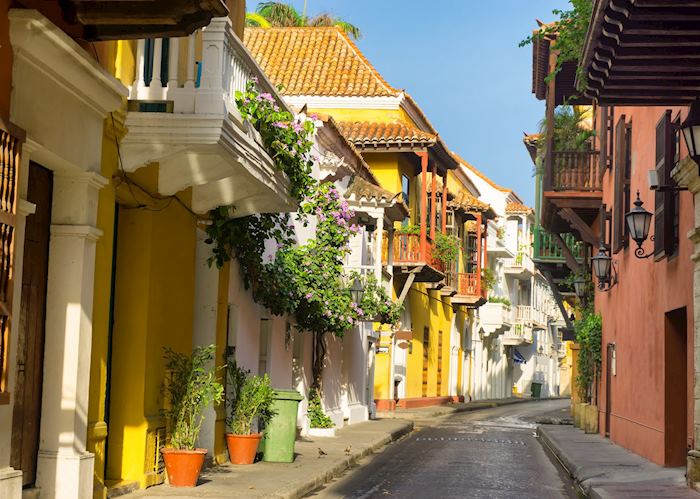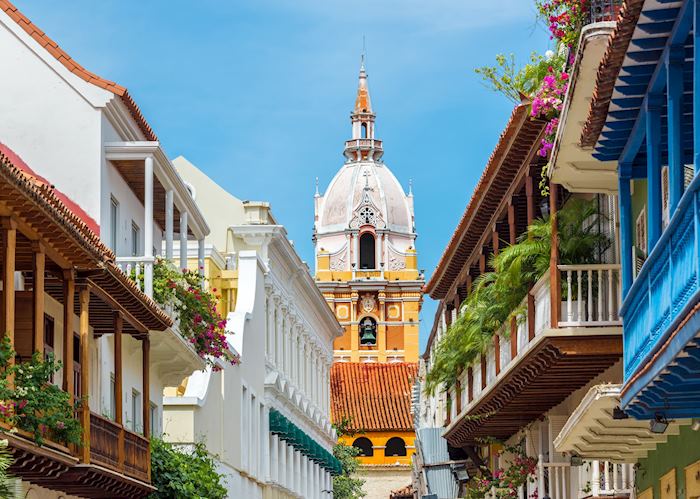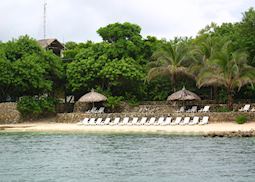Jump to:
A Caribbean coastal city with a soupy climate, Cartagena doesn’t have a long litany of sights to tick off: a visit is really about absorbing its ambience. Its old town is girded by a relic of the Spanish Empire, one of South America’s most celebrated pieces of colonial architecture: 11 km (6.8 miles) of zigzagging ramparts constructed from coral stone and punctuated by Moorish-like bastions. Beyond them, a warren of cobbled streets make up the old town with buildings painted in punchy primary shades, and a culture quite unlike that of the Paísa (the fair-skinned people of Colombia’s Andes and highlands).
In Cartagena, you’ll see that the majority of residents are Afro-Caribbean, with many women wearing headwraps and flowing dresses in bright palettes. But, the most vibrant manifestation of their culture comes in the form of the cumbia dance performances you’re likely to happen upon in the squares of the old town every afternoon.
 The city’s walls were first raised in 1563 to protect Spain’s booty of New-World gold, crops and slaves from ransacking pirates and privateers. Sir Francis Drake famously breached the ramparts, and had to be paid off with a shower of ducats.
The city’s walls were first raised in 1563 to protect Spain’s booty of New-World gold, crops and slaves from ransacking pirates and privateers. Sir Francis Drake famously breached the ramparts, and had to be paid off with a shower of ducats.
Today, you can best enjoy the walls on languorous afternoon strolls (a tradition called ‘paseo’) or even a guided walk. Do as the locals do, and stop off at one of the cafés lining the walkways. Here, you can look out over a huge sweep of the Caribbean Sea. Seats inevitably fill up around sunset.
While walking the walls, expect to see newlyweds or wannabe-models having photoshoots, or young girls decked out in rhinestoned, lacy ballgowns celebrating their quinceañera (a ‘coming of age’ ceremony held on their 15th birthday).
Aside from the walls, the city has three main architectural highlights. The Castillo de San Félipe de Barajas, the largest fort ever built by the Spanish colonialists, sits atop a grassy mound and looks almost like a multi-storey Mesoamerican pyramid. You can wiggle your way through its tunnels on a guided tour.
The white-stone 17th-century Convento de la Popa also occupies a hilltop vantage point. Its elegant cloister, partly shaded by frothy potted palms, is particularly welcoming on a hot day. Then there’s the city’s cathedral, also referred to as ‘Santa Catalina’, with its orangey-rose bell tower and surprisingly understated interior.
The best way to take in the old town is simply to wander around, admiring the zany yellow, hibiscus pink and cobalt blue shades of some of the buildings and their grandiose doors whose lintels are often festooned in climbing plants. Doors were something of a status symbol in Cartagena society: look out for their elaborate aldabas (knockers), some of which are designed in the shapes of animals: turtles, lizards, doves and seahorses, to name a few.
Outside the old town is the slowly-becoming-gentrified district of Getsemaní. Here, walls are painted with splashy, stylistic murals, locals gather to play card games in the middle of the street, and vendors sell arepas, corn pancakes often stuffed with meat, cheese, and avocado.
In the late afternoon and early evening, plazas in both the old town and Getsemaní come alive with impromptu cumbia dancing. Men in white sailor-like suits and women in ruffled, butterfly-like dresses stalk around each other barefoot to a background of drumming, and a melody often played on a wind instrument called a gaita.
Best time to visit Cartagena
The city has an extremely humid, sultry climate nearly all year round, with temperatures usually staying around 28°C (about 82°F). November can be busy, as the city prepares for its annual Independence Day celebrations on the 11th, but the atmosphere is electric. Be aware that December and January can also be hectic, as the city swells with an influx of domestic visitors over the Christmas period.
who's been there
-
01993 838 92501993 838 683
- Make an enquiry
Suggested itineraries featuring Cartagena
Our itineraries will give you suggestions for what is possible when you travel in Cartagena, and they showcase routes we know work particularly well. Treat them as inspiration, because your trip will be created uniquely by one of our specialists.
Places near Cartagena
- Caribbean Coast less than 5 miles away
- Santa Marta 107 miles away
- Tayrona National Park 118 miles away
- Los Llanos 219 miles away
- Medellín 288 miles away
Photos of Cartagena
Accommodation choices for Cartagena
We've selected a range of accommodation options for when you visit Cartagena. Our choices usually come recommended for their character, facilities and service or location. Our specialists always aim to suggest properties that match your preferences.
-
![Roof terrace, Casa San Agustin Cartagena]()
Casa San Agustín
Cartagena -
![Hotel Alfiz, Cartagena]()
Alfiz Hotel Boutique
Cartagena -
![Sofitel Santa Clara, Colonial Suite, Cartagena]()
Sofitel Legend Santa Clara
Cartagena -
![Hotel Ananda, Cartagena]()
Hotel Ananda
Cartagena -
![Hotel Las Islas, Baru]()
Hotel Las Islas
Cartagena
Ideas for experiencing Cartagena
Our specialists seek out authentic ways to get to know the places that could feature in your trip. These activities reflect some of the experiences they've most enjoyed while visiting Cartagena, and which use the best local guides.
-
Day trip to Isla Majagua ![Hotel San Pedro de Majagua, Islas del Rosario]()
Day trip to Isla Majagua
Day trip to Isla Majagua
Time to take to the waters of the Caribbean for a day trip out to Hotel San Pedro de Majagua located on one of the islands of the Isla Rosario chain.
View details -
Half-day tour of colonial Cartagena ![Cartagena, Colombia]()
Half-day tour of colonial Cartagena
Half-day tour of colonial Cartagena
This leisurely half-day tour on foot of Cartagena’s idyllic old colonial town works wonderfully as a small history lesson combined with some stunning architecture.
View details -
Cartagena city tour ![Cartagena, Colombia]()
Cartagena city tour
Cartagena city tour
This half day tour takes you to the Castillo de San Félipe de Barajas — the greatest fortress ever built by the Spanish in the colonies. It is an impressive structure erected between 1639 an 1657.
View details























